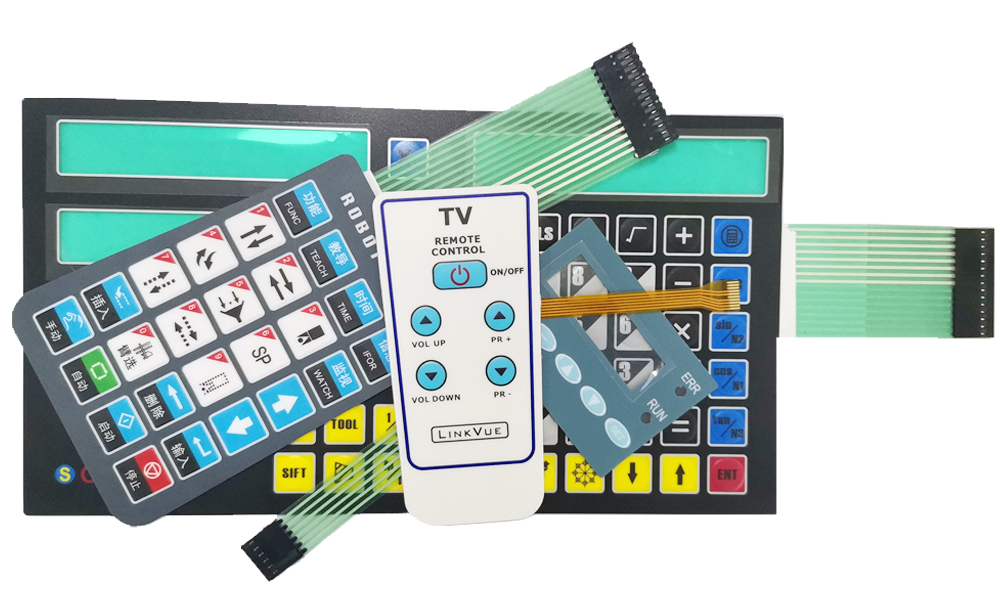
 Tel: +86755-27523807 +8613715205860(wechat/whatsapp)
Tel: +86755-27523807 +8613715205860(wechat/whatsapp) Email: jcf@jcftechnology.com
Email: jcf@jcftechnology.com

 Tel: +86755-27523807 +8613715205860(wechat/whatsapp)
Tel: +86755-27523807 +8613715205860(wechat/whatsapp) Email: jcf@jcftechnology.com
Email: jcf@jcftechnology.com
Membrane switch inspection
1. Shape: size, conductive circuit, insulation, backplane combination, etc. should comply with the drawings or provide physical samples.
2. Material: Membrane panels, silver paste, carbon ink, spacers, adhesives, reinforcing plates, and insulating layer printing should comply with the drawings.
3. Check appearance quality: the scope of this check is wide.
Panel: There must be no obvious defects (such as lack of strokes in characters that affect readability; stains, light transmission points; deinking, stains, scratches; transparent window overflow, residual glue, etc.); no offset phenomenon (printing sleeve Plate deviation ≤ 0.2mm; upper and lower circuit key position combination deviation ≤ 0.5mm; circuit and key sheet, panel and face key combination deviation ≤ 0.3mm; panel and circuit combination after the surrounding blank area deviation ≤ 0.2mm; panel The offset between the button bump and the substrate is ≤0.5mm).
Circuit: There must be no residual material scraps, foreign matter, stains, bumps, grease attached to the surface and inside, fingerprints on the circuit, and burrs on the edge of the finished product; all circuits and contacts must not have cuts through the surface and the inside (the cut marks are caused by The circuit is cut to the substrate), and minor scratches are also based on the principle of not affecting its impedance. The carbon ink surface scratches are based on the principle of not affecting the circuit conduction. The circuit must not have any foreign matter attached to it.
Punching burrs and tool size: Punching burrs and tool size should not be greater than 0.2mm, and the position should be toward the side without conductors.
4. Color proofreading: Use visual inspection to compare with the sample to see if there is any color difference. The color requirements are particularly strict with a colorimeter.
5. Ink adhesion check: the ink is attached to the transparent tape and pressed by hand to ensure that there are no bubbles and then peel off quickly after 10 seconds, and there should be no ink falling. After the insulating ink is dried, press the ink surfaces against each other and press for 24 hours to ensure that the insulation does not stick to each other. After 1 minute of sticking with pressure-sensitive tape without bubbles by hand, it peeled off quickly and no ink came off.
6. Embossing quality: equal height and balanced strength. Flat button: 57~284g force, touch button: 170~397g force.
7. Peel strength: The peel strength of the glue should not be less than 8N/25mm.
8. Bend resistance strength: After drying the silver paste, carbon ink circuit or silver circuit covered with carbon ink, the loop resistance should be measured first, and then the circuit should be folded 180 degrees, and the finger should be pressed for 2kg/2 seconds , And then make it return to the plane, repeat it for 5 times, and then measure its resistance. The resistance increased after being folded 5 times does not exceed 300% of the original resistance.
9. Hardness: Use H grade drawing pen tip, apply 1kg thrust to the circuit at 45 degrees, and the circuit must not peel off the conductive ink or produce light transmission.
10. Dimensions: the allowable tolerances not marked on the drawings, and the rest comply with the drawings.
11. Loop resistance: The resistance of the loop should not be greater than 100Ω. For the total length of the loop greater than 150cm and special requirements, the loop resistance is separately specified on the drawing.
12. Insulation resistance: In a normal temperature and humidity environment, the insulation resistance of the conductor line is greater than 500MΩ (500VDC for 1 minute). After high temperature and constant humidity test, salt spray test, it should not be less than 20MΩ.
13. Life: The number of contacts and conduction times per button without reed should be over 1 million times. There are tactile conduction times, which should be 500,000 times.
14. High temperature: After the membrane switch is subjected to a high temperature of 55±2°C for 72 hours, the appearance quality of the membrane switch should meet the requirements of the drawing. After recovering for 2 hours under normal atmospheric conditions, the measured insulation resistance value should meet the requirements.
15. Low temperature: After the membrane button is subjected to a low temperature of -10±3°C for 16 hours, it will be restored under normal atmospheric conditions for 2 hours, and the water droplets on the surface will be wiped off. The measured loop resistance value should meet the requirements.
16. Constant heat and humidity: The membrane switch panel is subjected to 40±2℃, relative humidity is 93 (+2% -3%), after 96 hours of constant heat and humidity test, it is restored for 2 hours under normal atmospheric conditions, and the insulation resistance and circuit are measured. The resistance and keypad force should meet
